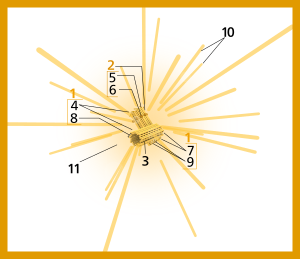
Back جسيم مركزي Arabic Центрозома Bulgarian সেন্ট্রোজোম Bengali/Bangla Centrosom BS Centrosoma Catalan Centrozom Czech Zentrosom German Κεντροσωμάτιο Greek Centrosoma Spanish Tsentrosoom Estonian
| Cell biology | |
|---|---|
| centrosome | |
 Components of a typical centrosome:
|
In cell biology, the centrosome (Latin centrum 'center' + Greek sōma 'body') (archaically cytocentre[1]) is an organelle that serves as the main microtubule organizing center (MTOC) of the animal cell, as well as a regulator of cell-cycle progression. The centrosome provides structure for the cell. The centrosome is thought to have evolved only in the metazoan lineage of eukaryotic cells.[2] Fungi and plants lack centrosomes and therefore use other structures to organize their microtubules.[3][4] Although the centrosome has a key role in efficient mitosis in animal cells, it is not essential in certain fly and flatworm species.[5][6][7]
Centrosomes are composed of two centrioles arranged at right angles to each other, and surrounded by a dense, highly structured[8] mass of protein termed the pericentriolar material (PCM). The PCM contains proteins responsible for microtubule nucleation and anchoring[9] — including γ-tubulin, pericentrin and ninein. In general, each centriole of the centrosome is based on a nine-triplet microtubule assembled in a cartwheel structure, and contains centrin, cenexin and tektin.[10] In many cell types, the centrosome is replaced by a cilium during cellular differentiation. However, once the cell starts to divide, the cilium is replaced again by the centrosome.[11]
- ^ "Structure of Plants and Fungi|Digitális Tankönyvtár". regi.tankonyvtar.hu (in Hungarian). Retrieved 2021-01-30.
- ^ Bornens, M.; Azimzadeh, J. (2008). "Origin and Evolution of the Centrosome". Eukaryotic Membranes and Cytoskeleton. pp. 119–129. doi:10.1007/978-0-387-74021-8_10. ISBN 978-0-387-74020-1. PMID 17977464.
- ^ Schmit (2002). Acentrosomal microtubule nucleation in higher plants. International Review of Cytology. Vol. 220. pp. 257–289. doi:10.1016/S0074-7696(02)20008-X. ISBN 9780123646248. PMID 12224551.
- ^ Jaspersen, S. L.; Winey, M. (2004). "THE BUDDING YEAST SPINDLE POLE BODY: Structure, Duplication, and Function". Annual Review of Cell and Developmental Biology. 20 (1): 1–28. doi:10.1146/annurev.cellbio.20.022003.114106. PMID 15473833.
- ^ Mahoney, N. M.; Goshima, G.; Douglass, A. D.; Vale, R. D. (2006). "Making Microtubules and Mitotic Spindles in Cells without Functional Centrosomes". Current Biology. 16 (6): 564–569. doi:10.1016/j.cub.2006.01.053. PMID 16546079.
- ^ Cite error: The named reference
azimzadehscience2012was invoked but never defined (see the help page). - ^ Cite error: The named reference
stowerspr2012was invoked but never defined (see the help page). - ^ Lawo, Steffen; Hasegan, Monica; Gupta, Gagan D.; Pelletier, Laurence (November 2012). "Subdiffraction imaging of centrosomes reveals higher-order organizational features of pericentriolar material". Nature Cell Biology. 14 (11): 1148–1158. doi:10.1038/ncb2591. ISSN 1476-4679. PMID 23086237. S2CID 11286303. Archived from the original on 2021-07-25. Retrieved 2020-08-07.
- ^ Eddé, B.; Rossier; Le Caer; Desbruyères; Gros; Denoulet (1990). "Posttranslational glutamylation of alpha-tubulin". Science. 247 (4938): 83–85. Bibcode:1990Sci...247...83E. doi:10.1126/science.1967194. PMID 1967194.
- ^ Rieder, C. L.; Faruki, S.; Khodjakov, A. (Oct 2001). "The centrosome in vertebrates: more than a microtubule-organizing center". Trends in Cell Biology. 11 (10): 413–419. doi:10.1016/S0962-8924(01)02085-2. ISSN 0962-8924. PMID 11567874.
- ^ Avidor-Reiss, T; Gopalakrishnan, J (2013). "Cell Cycle Regulation of the Centrosome and Cilium". Drug Discov Today Dis Mech. 10 (3–4): e119–e124. doi:10.1016/j.ddmec.2013.03.002. PMC 4073209. PMID 24982683.
© MMXXIII Rich X Search. We shall prevail. All rights reserved. Rich X Search